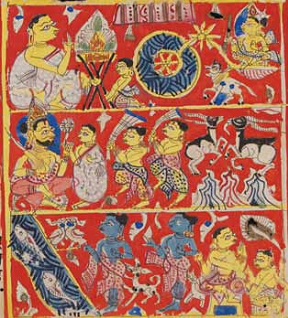
Centre of Jaina Studies Newsletter: SOAS - University of London
The status and importance of the dialogue between the brothers Citta and Saṃbhūta in the Buddhist and Jain canons have been considerably diminished by its being presented, to an extent by tradition, and apparently definitively by Ernst Leumann (WZKM, 5, 1891 and 6, 1892) as an episode extracted from an extensive pre-existing corpus of Brahmadatta legends. This 'Gesamtlegende' would have surfaced briefly in the Buddhist Citta-Saṃbhūta-Jātaka (an Uttarapañcālarājā, with three pre-births) and Hindu Mahābhārata 12.330 (Brahmadatta's seven births, etc.), and extensively in the Jain Uttarajjhāyā, cantos 13-14 with prose commentary, in Maṇivaicariya, and in Harivaṃśa, etc. (Pañcālarāyā Bambhadatto / Brahmadatta's adventures, mastery of the speech of birds, treatment of brahmins, his offspring, and his dynasty). Leumann's diagram (1892, p. 21) purported to describe how the latter's tally of seven incarnations of seven companions was eventually reduced, in Jātaka 498, to two brothers in four births, and restored to two brothers in six births (including Pañcālarāyā Bambhadatto) in Uttarajjhāyā 13. Thomas Oberlies, in an elaboration of Leumann's researches (Berliner Indologische Studien, 9/10, 1996), reported favourably (p. 274) Leumann's suspicion that the number of births might have been increased to match the number of companions, but he did not venture to decide (p. 260, n.) whether this postulation of a pre-existing complex Brahmadatta cycle was really justified.
A result of attempts to visualize an original Triṣṭubh text underlying both Jātaka 498 and Utt. canto 13 has been to introduce a difference of opinion as to who speaks first in the Triṣṭubh dialogue in the Prakrit. Following its Āryā and Anuṣṭubh preamble, the commentaries, Hermann Jacobi's translation (SBE, 1895), and the Indian translations, assign the initial Triṣṭubh v. 10 to Citta, but then have some difficulty in making sense of the wording. Leumann, followed by Ludwig Alsdorf (Fel. Vol. Belvalkar, 1957, 206), assigned it to Saṃbhūya, incarnate as King Bambhadatta. It seems, however, possible to resolve the discrepancy in favour of the tradition.
Utt. 13 has, first, three Māhārāṣṭrī Āryā verses which, as Alsdorf showed, briefly versify the prose mise-enscène: an unnamed merchant's son, previously lowborn as Citta in Hatthiṇapura, encounters Bambhadatta, previously his brother Saṃbhūya, and they discuss their respective fates and fortunes. There follow six Māhārāṣṭrī Anuṣṭubhs that quote Bambhadatta as remembering five previous fraternal births, and the erstwhile Citta as realizing that Saṃbhūya's overweening ambition has occasioned their current alienation. This application of Jain nidāna theory, the idea that Saṃbhūya's dying wish could determine his status in a future life, bears out the intimation in the prose matrix that the rich merchant's son has become a mendicant monk. Bambhadatta then exults in his acquired lofty regal status and asks: can the other say as much? These Āryās and Anuṣṭubhs are matched in the Jātaka with, respectively, the notion of an introductory exchange of 'recognition' verses (Triṣṭubh gāthās 1-5) and Citta's recollection of three previous births (Anuṣṭubh g. 16), as against the one birth acknowledged in the Prakrit Triṣṭubhs. In the mediaeval Jain prose, the Pali notion of recognition verses is pared down to a couple of Sanskrit recognition half-verses, and the Prakrit Anuṣṭubh list of births is increased with the prefixing of a cow-herd existence.

Uttarādhyayanasūtra: Cittasaṃbhūijja (Detail)
Gujarat, Jain, ca. 1460
© Victoria and Albert Museum
Museum Number: IS 2:12/2-1972
This can be evidence rather of epigonic collusion than of the re-emergence of Ur-text material, as can the rough correspondence between two Anuṣṭubh verses, the Jain v. 6 dāsā... āsī, miyā..., haṃsā..., sovāgā... 'we were serfs, deer, geese, outcasts' and the Buddhist g. 16 caṇḍālā'humha, migā..., ukkusā...'we were outcasts, deer, ospreys'. This correspondence, contradicting the hypothesis of a nuclear purely Triṣṭubh dialogue, has created anxiety about the discrepant positioning of these merely analogous lists of births in the two texts. An ultimate source may be observed, not in a Sanskritic 'Gesamtlegende', but rather in the fact that Saṃyuttanikāya's Cittasaṃyuttaṃ (IV, 297-303), tells of a householder Citta who outwits Nigaṇṭha Nātaputta and refuses to secure a vainglorious future as Cakkavattī by means of a dying wish (praṇidhāna). Citta, understood there, judging by his preoccupation with cittasaṅkhāra and cetovimutti (293-297), as 'wise' rather than as the citra 'excellent' of Jain tradition, evidently has a part in the evolution of the Citta-Saṃbhūta story: but that he should have usurped the rebirth motif from Saṃbhūta (Oberlies, 267, n.), rather than vice versa, is by no means obvious.
In the instance in question, the observation attributed to Citta in Utt. 13 (translated below)
| v.10 | savvaṃ suciṇṇaṃ saphalaṃ narāṇã, kaḍāṇã kammāṇã na mokkha atthi, atthehĩ kāmehĩ ya uttamehĩ āyā mamaṃ puṇṇa-phalôvavee. |
| v.11 | jāṇāhi Saṃbhūya mahāṇubhāgaṃ mahiḍḍhiyaṃ puṇṇa-phalôvaveyaṃ, Cittaṃ pi jāṇāhi taheva, rāya(ṃ), iḍḍhī juī tassa-vi ya ppabhūyā. |
is matched in Jātaka 498 with the following verses attributed to the King
| g.1 | sabbaṃ narāṇaṃ saphalaṃ suciṇṇaṃ, na kammanā kiñcana mogham atthi, passāmi Saṃbhūtaṃ mahānubhāvaṃ sakammanā puññaphalūpapannaṃ. |
| g.2 | sabbaṃ (etc.), kaccin nu Cittassa pi evam eva iddho mano yathāpi mayhaṃ? |
to which Citta's reply is
| g.3 | sabbaṃ (etc.), Cittaṃ vijānāhi tah'eva, deva, iddho mano tassa yathāpi tuyhaṃ. |
The Pali of the Jātaka, twice repeating the first hemistich and introducing a go-between character appropriate to the recognition-verse motif of its prose, presents no problem. '1 Men's every good deed bears fruit, none of one's actions is in vain. I observe that the illustrious Saṃbhūta has achieved the auspicious reward of his actions. 2 Men's (etc.). I wonder if Citta's inclination has prospered as has mine. 3 Men's (etc.). Know Citta to be likewise, his inclination has prospered as has thine.' The word mano presumably embodies the motif of a deathbed state of mind, and is possibly masculine in keeping with a Pali play on the name citto. There seems to be no necessity for Alsdorf's view (p. 206) that passāmi Saṃbhūtaṃ mahānubhāvaṃ 'does not make sense in g. 1, spoken by the king, and must therefore be corrected to passāhi': 'I observe that I have prospered' is at least as good as 'observe that I have prospered'. His suggestion that we read Cittaṃ pi as in the Prakrit in g. 3, rather than Cittaṃ vi- is more attractive, but is rather a question of a Prakritism -ṃ vi for -ṃ pi in the Pali than an actual error.
In Bambhadatta's question in the final Prakrit Anuṣṭubh (v. 9d kiṃ-nu Citte vi se tahā? 'Is that so for Citta too?') Citte vi is locative, as presumably implied by Jacobi ('in your case, Citra'): recent renderings supplement a nominative gloss with a verb (Citro'pi tāni tathā paribhuṅkte) but translate with an explicit, but impossible vocative. The Cuṇṇī's genitive (Citrasyāpi evaṃvidhā ṛddhir yathā) could conceivably indicate familiarity with the Pali Triṣṭubhs: g. 2 Cittassa pi... mano and g. 3 mano tassa.
Citta's response, the initial Prakrit Triṣṭubh (v. 10),
All men's good deeds bear fruit, there is no release from actions one has done; with the highest riches and aspirations my soul has attained the fruits of merit.
is actually quite in keeping with the Jain fondness for reinterpreting secular concepts in a religious sense, vijaya, dhuta, upadhāna, yajña, etc., and here artha and kāma. Amar Muni's laconic rendering of atthehĩ kāmehĩ ya uttamehĩ simply as 'rewards' (Sacitra Utt. Sū., 1992), and even Jacobi's awkward translation 'through riches and the highest pleasures', are presumably meant to convey Citta's equivocal allusion to the rich family that he has renounced and the ascetic values he has acquired. The verse was, however, ascribed by Leumann (1891, pp. 123, 134) to Bambhadatta, in keeping with the Pali parallel g. 1, since he considered that v. 10cd atthehĩ kāmehĩ ya uttamehĩ āyā mamaṃ puṇṇa-phalôvavee (in his rendering 'Ich habe alles was ich möchte, Verdienst schuf mir das Glück des Lebens') could be said only by the King. His contention, on the other hand, that the monkish remark in v. 10b kaḍāṇã kammāṇã na mokkha atthi ('Die That, verübt, gibt keine Rettung') could not possibly be attributed to the King was met by an assumption that the words represented a mishearing of the version preserved in Pali: na kammanā kiñcana mogham atthi 'none of one's deeds is in vain', and so must be corrected accordingly ('Kein Werk ist je allhier vergebens'). Alsdorf (p. 206) similarly identified v. 11 as 'the first part of the monk's answer', although this introduces a non sequitur: Bambhadatta asks a question in the v. 9 Anuṣṭubh, but he would interpolate some selfcongratulation in the initial Triṣṭubh v. 10, before Citta can reply in v.11. We lose the piquancy of the King's arrogant inquiry 'Can you say the same?', and the monk's immediate retort 'I can say more'. As Alsdorf wrote of the two texts (p.203f.): 'only in a very few cases is there complete correspondence between two stanzas; there are others which agree in one pāda only, while the rest is totally different. This can only be taken to mean that there was indeed an old poem in Upajāti metre which became the source of both the Jāt[aka] and the Utt[arajjhāya] ballad, but that both the Buddhist and the Jain redactors, while keeping to the Upajāti metre, dealt with this old poem in the most arbitrary manner'. The discrepancy between the assigning of the Pali g. 1 to the King and the Prakrit v. 10 to Citta is a case in point.
In this case, Leumann's recourse to the Pali for guidance is unjustified, since the kiñci on which the genitive kammanā depends is absent in the Prakrit: simply replacing mokkha with mo(g)haṃ does not make sense. Correcting minor flaws in the wording of the Prakrit text with the help of the Pali is another matter. There can be little doubt but that in v. 11 we should read 'jāṇā[m]i Saṃbhūy[ã] mahāṇubhā[v]aṃ mahiḍḍhiyaṃ puṇṇa-phalôvaveyaṃ', rather than 'jāṇāhi Saṃbhūya' (modified in the Cūrṇī to yathā tvaṃ jānāsi): 'I know that you, Saṃbhūya, are illustrious and powerful on having attained the fruits of merit; know, sire, that I, Citta, am so likewise: great power and glory are mine too'. Accidental anticipation of the correlative Cittaṃ pi jāṇāḥi in the following line is nothing unusual; accusative Saṃbhūyaṃ is required for the sense; and mahāṇubhāgaṃ is an evident hyper-correction for mahāṇubhāaṃ. The Pali with passāmi Saṃbhūtaṃ mahānubhāvaṃ is adequate confirmation. It is surprising that, while adopting *jāṇāmi, Alsdorf ignored the possibility that Saṃbhūya is merely a graphic representation of a metrically short accusative.
Citta's attempt to convert Saṃbhūya, as worked up in prose and Anuṣṭubhs into a saga of several rebirths, is a notable contribution to the thesis developed in the Uttarajjhāyā as a whole. As Herman Tieken shows ('On the composition of the Utt.', to appear), the text teaches that māṇusattaṃ 'human status', suī 'the acquisition of requisite knowledge', saddhā 'application thereof', and saṃjamammi vīriyaṃ 'resolute perseverance in self-control' are goals that are progressively harder to achieve. The fact that in the Jain story Saṃbhūya fails, and pays the penalty, makes for a more impressive document than is provided in the Buddhist version, with its prose framework involving a Bodhisatta in the form of Citta who naturally succeeds in equipping the King for admission to Brahmaloka.
J.C.Wright is Emeritus Professor of Sanskrit in the University of London, and Senior Research Fellow in the School of Oriental and African Studies, London.

Abhiṣeka of an image of the Jina Candraprabha in Narasiṃharājapura.
(Photo: Ingrid Schoon, 2014.)
 Prof. J.C. Wright
Prof. J.C. Wright